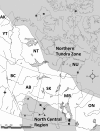Detection of European strain of Echinococcus multilocularis in North America
- PMID: 22608114
- PMCID: PMC3358155
- DOI: 10.3201/eid1806.111420
Detection of European strain of Echinococcus multilocularis in North America
Figures

Similar articles
-
Alveolar hydatid disease (Echinococcus multilocularis) in the liver of a Canadian dog in British Columbia, a newly endemic region.Can Vet J. 2012 Aug;53(8):870-4. Can Vet J. 2012. PMID: 23372195 Free PMC article.
-
Pasture types and Echinococcus multilocularis, Tibetan communities.Emerg Infect Dis. 2006 Jun;12(6):1008-10. doi: 10.3201/eid1206.041229. Emerg Infect Dis. 2006. PMID: 16707064 Free PMC article.
-
Larval Echinococcus multilocularis infection in a dog.Vet Rec. 1997 Jul 12;141(2):49-50. doi: 10.1136/vr.141.2.49. Vet Rec. 1997. PMID: 9253833 No abstract available.
-
Echinococcus multilocularis in North America: the great unknown.Parasite. 2014;21:73. doi: 10.1051/parasite/2014069. Epub 2014 Dec 23. Parasite. 2014. PMID: 25531581 Free PMC article. Review.
-
Assessment of the global pattern of genetic diversity in Echinococcus multilocularis inferred by mitochondrial DNA sequences.Vet Parasitol. 2018 Oct 15;262:30-41. doi: 10.1016/j.vetpar.2018.09.013. Epub 2018 Sep 27. Vet Parasitol. 2018. PMID: 30389009 Review.
Cited by
-
Age-dependent relationships among diet, body condition, and Echinococcus multilocularis infection in urban coyotes.PLoS One. 2023 Aug 30;18(8):e0290755. doi: 10.1371/journal.pone.0290755. eCollection 2023. PLoS One. 2023. PMID: 37647321 Free PMC article.
-
Deep amplicon sequencing highlights low intra-host genetic variability of Echinococcus multilocularis and high prevalence of the European-type haplotypes in coyotes and red foxes in Alberta, Canada.PLoS Negl Trop Dis. 2021 May 26;15(5):e0009428. doi: 10.1371/journal.pntd.0009428. eCollection 2021 May. PLoS Negl Trop Dis. 2021. PMID: 34038403 Free PMC article.
-
Alveolar echinococcosis in a dog in Missouri, USA.J Vet Diagn Invest. 2022 Jul;34(4):746-751. doi: 10.1177/10406387221104754. Epub 2022 Jun 9. J Vet Diagn Invest. 2022. PMID: 35678137 Free PMC article.
-
Molecular characterization of human Echinococcus isolates and the first report of E. canadensis (G6/G7) and E. multilocularis from the Punjab Province of Pakistan using sequence analysis.BMC Infect Dis. 2020 Apr 3;20(1):262. doi: 10.1186/s12879-020-04989-6. BMC Infect Dis. 2020. PMID: 32245373 Free PMC article.
-
Editorial overview: From farms and forests to forks? A review of diagnosis and management of globally important zoonotic Echinococcus spp. cestodes.Food Waterborne Parasitol. 2019 Jun 27;16:e00061. doi: 10.1016/j.fawpar.2019.e00061. eCollection 2019 Sep. Food Waterborne Parasitol. 2019. PMID: 32095631 Free PMC article.
References
Publication types
MeSH terms
Substances
Associated data
- Actions
- Actions
LinkOut - more resources
Full Text Sources
